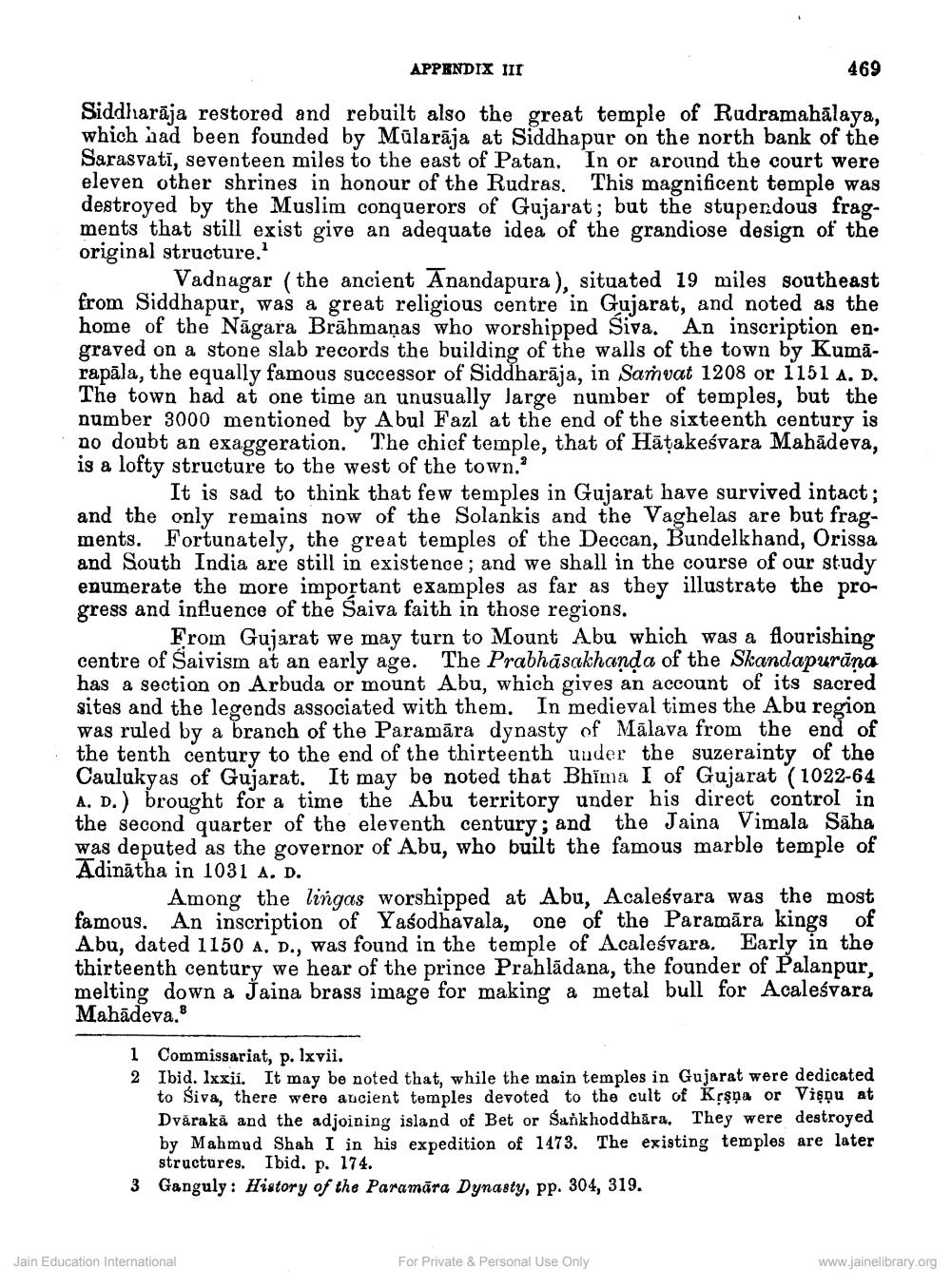________________
APPENDIX III
Siddharaja restored and rebuilt also the great temple of Rudramahalaya, which had been founded by Mularāja at Siddhapur on the north bank of the Sarasvati, seventeen miles to the east of Patan. In or around the court were eleven other shrines in honour of the Rudras. This magnificent temple was destroyed by the Muslim conquerors of Gujarat; but the stupendous fragments that still exist give an adequate idea of the grandiose design of the original structure.'
469
Vadnagar (the ancient Anandapura), situated 19 miles southeast from Siddhapur, was a great religious centre in Gujarat, and noted as the home of the Nagara Brāhmaṇas who worshipped Siva. An inscription engraved on a stone slab records the building of the walls of the town by Kumarapala, the equally famous successor of Siddharaja, in Samvat 1208 or 1151 A. D. The town had at one time an unusually large number of temples, but the number 3000 mentioned by Abul Fazl at the end of the sixteenth century is no doubt an exaggeration. The chief temple, that of Haṭakeśvara Mahadeva, is a lofty structure to the west of the town.
It is sad to think that few temples in Gujarat have survived intact; and the only remains now of the Solankis and the Vaghelas are but fragments. Fortunately, the great temples of the Deccan, Bundelkhand, Orissa and South India are still in existence; and we shall in the course of our study enumerate the more important examples as far as they illustrate the progress and influence of the Saiva faith in those regions.
From Gujarat we may turn to Mount Abu which was a flourishing centre of Saivism at an early age. The Prabhasakhanda of the Skandapurāna has a section on Arbuda or mount Abu, which gives an account of its sacred sites and the legends associated with them. In medieval times the Abu region was ruled by a branch of the Paramara dynasty of Malava from the end of the tenth century to the end of the thirteenth under the suzerainty of the Caulukyas of Gujarat. It may be noted that Bhima I of Gujarat (1022-64 A. D.) brought for a time the Abu territory under his direct control in the second quarter of the eleventh century; and the Jaina Vimala Saha was deputed as the governor of Abu, who built the famous marble temple of Adinatha in 1031 A. D.
Among the lingas worshipped at Abu, Acaleśvara was the most famous. An inscription of Yasodhavala, one of the Paramāra kings of Abu, dated 1150 A. D., was found in the temple of Acaleśvara. Early in the thirteenth century we hear of the prince Prahladana, the founder of Palanpur, melting down a Jaina brass image for making a metal bull for Acaleśvara Mahadeva.R
Jain Education International
1 Commissariat, p. lxvii.
2 Ibid. lxxii. It may be noted that, while the main temples in Gujarat were dedicated to Siva, there were ancient temples devoted to the cult of Krsna or Viṣņu at Dvaraka and the adjoining island of Bet or Sankhoddhara, They were destroyed by Mahmud Shah I in his expedition of 1473. The existing temples are later structures. Ibid. p. 174.
3 Ganguly: History of the Paramāra Dynasty, pp. 304, 319.
For Private & Personal Use Only
www.jainelibrary.org




